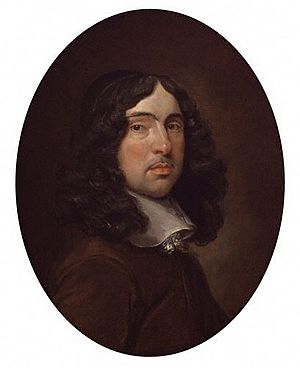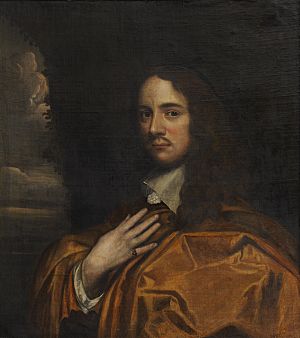Andrew Marvell facts for kids
Quick facts for kids
Andrew Marvell
|
|
|---|---|

Andrew Marvell (between c. 1655 and c. 1660)
|
|
| Born | 31 March 1621 Winestead, England |
| Died | 16 August 1678 (aged 57) London, England |
| Occupation | Poet |
| Alma mater | Trinity College, Cambridge |
| Notable works | "To His Coy Mistress", "The Garden", "An Horatian Ode" |
Andrew Marvell (born March 31, 1621 – died August 16, 1678) was an English poet, writer, and politician. He is known as a "metaphysical poet" because of his unique style. Marvell was a Member of Parliament for many years. During a time when England was a republic (the Commonwealth), he was a close friend and colleague of the famous poet John Milton.
Marvell wrote many different kinds of poems. Some were romantic, like "To His Coy Mistress". Others described beautiful country houses and gardens, such as "Upon Appleton House" and "The Garden". He also wrote political poems, like "An Horatian Ode upon Cromwell's Return from Ireland", and later, funny but critical writings about politics.
Contents
Early Life and Education

Andrew Marvell was born in Winestead, a small village in Yorkshire, England. His father, also named Andrew Marvell, was a church leader. When Andrew was young, his family moved to Kingston upon Hull (often called Hull). His father became a lecturer at Holy Trinity Church there.
Marvell went to Hull Grammar School. At 13, he started studying at Trinity College, Cambridge, a famous university. He earned a degree there. You can still see a portrait of him at Trinity College today.
After college, around 1642, Marvell likely traveled around Europe. England was going through a difficult time with the English Civil War. Marvell stayed on the continent until 1647. During his travels, he learned several languages, including French, Italian, and Spanish.
Becoming a Tutor and Poet
Marvell's first poems were written in Latin and Greek while he was still at Cambridge. These early poems were about a terrible plague and the birth of a child to King Charles I.
After King Charles I was executed in 1649, Marvell began to support the new government. This government was called the Interregnum. His poem "Horatian Ode," written around 1650, shows his mixed feelings about the king's death. It praises Oliver Cromwell, who was a powerful leader at the time.
Around 1650 to 1652, Marvell worked as a tutor. He taught the daughter of Lord General Thomas Fairfax. Fairfax had been the leader of the Parliament's army before Cromwell took over. Marvell lived at Nun Appleton Hall near York during this time. Here, he wrote more poems. One famous poem from this period is "To His Coy Mistress".
Working for the Government
In 1652, tensions grew between England and the Netherlands, leading to the First Anglo-Dutch War. Marvell wrote a poem called "Character of Holland," which made fun of the Dutch.
In 1653, Marvell became a tutor to William Dutton, who was a ward of Oliver Cromwell. They lived together in Eton. This is likely when Marvell wrote his poem Bermudas, inspired by trips to Bermuda. He also wrote several poems praising Cromwell, who was then the Lord Protector of England. In 1656, Marvell and Dutton traveled to France.
In 1657, Marvell started working with John Milton, who was by then blind. Marvell became a Latin secretary for Cromwell's government. This job paid well and gave him financial stability.
After Oliver Cromwell died in 1658, his son Richard became Lord Protector. In 1659, Marvell was elected as a Member of Parliament for Kingston upon Hull. He was paid for his time in Parliament by his hometown. He was re-elected in 1660.
After the Monarchy Returned

In 1660, the monarchy was restored, and King Charles II returned to power. Marvell had worked with Cromwell, but he was not punished for it. In fact, he helped convince the King not to execute John Milton for his writings against the monarchy.
Marvell and Milton remained close friends. Marvell even wrote a beautiful poem called "On Mr. Milton's Paradise Lost" for the second edition of Milton's famous epic poem, Paradise Lost.
In 1661, Marvell was re-elected as an MP for Hull. He began to write long, critical poems about the corruption in the King's court. These poems were very sensitive politically. They were usually shared as handwritten copies and were too dangerous to be published with his name until after he died.
Marvell strongly opposed the "court party," which was the group around the King. In his longest poem of this type, Last Instructions to a Painter (1667), Marvell criticized the political corruption that led to England's failures during the Second Anglo-Dutch War. This poem was only published much later, after 1688. It describes a government without a strong navy, led by dishonest and cowardly officials.
From 1659 until his death in 1678, Marvell also worked as an agent for the Hull Trinity House, a group of shipmasters. He went on two trips to other countries: one to the Netherlands and another to Russia, Sweden, and Denmark. He lived in a small house in north London for some time.
Andrew Marvell died suddenly in 1678. He had been in good health, so some people thought he might have been poisoned by his political enemies. However, this was never proven. He was buried in a church in central London.
His Writings
Marvell also wrote anonymous prose works, which are like essays or pamphlets. These writings criticized the monarchy and the Roman Catholic Church. He defended Puritan groups and spoke out against censorship.
One of his works, The Rehearsal Transpros'd, was published in 1672 and 1673. It was an attack on a writer named Samuel Parker.
Another work, Mr. Smirke; or The Divine in Mode (1676), criticized the Church of England for being intolerant.
Marvell's pamphlet An Account of the Growth of Popery and Arbitrary Government in England, published in 1677, claimed that there was a plan to change England's government into a tyranny and to replace the Protestant religion with Catholicism. This pamphlet was very important at the time.
What Made His Poems Special
Marvell's poems often followed the popular styles of his time. For example, his famous poem "To His Coy Mistress" uses the "carpe diem" idea, which means "seize the day." This idea encourages people to enjoy life now because time passes quickly.
Marvell took these familiar styles and added his own unique ideas, comparisons, and deep thoughts about life and death. The writer T. S. Eliot described Marvell's style as having "a tough reasonableness beneath the slight lyric grace." This means his poems were beautiful and graceful, but also had strong, smart ideas behind them.
"To His Coy Mistress" is Marvell's most famous poem. It combines the old idea of convincing a lover to act now with Marvell's lively descriptions and easy-to-read rhyming lines. Other poems he wrote included political satire and religious themes.
Marvell was known for his honesty and integrity. Many of his poems were not published until 1681, three years after he died.
Legacy
A secondary school in Hull, the Andrew Marvell Business and Enterprise College, is named after him.
See also
 In Spanish: Andrew Marvell para niños
In Spanish: Andrew Marvell para niños
- List of works by Andrew Marvell
- The Marvell College
- Andrew Marvel (1812 ship) - ship built at Kingston upon Hull that made some 24 voyages as a Greenland whaler


